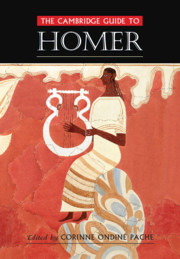Book contents
- The Cambridge Guide to Homer
- The Cambridge Guide to Homer
- Copyright page
- Contents
- Figures
- Notes on the Contributors
- General Introduction
- Part I Homeric Song and Text
- Part II Homeric World
- Part III Homer in the World
- Introduction
- Homer in Antiquity
- Homer and the Latin West in the Middle Ages
- Homer in Greece from the End of Antiquity 1: The Byzantine Reception of Homer and His Export to Other Cultures
- Homer in Greece from the End of Antiquity 2: Homer after Byzantium, from the Early Ottoman Period to the Age of Nationalisms
- Homer in Renaissance Europe (1488‒1649)
- Homer in Early Modern Europe
- The Reception of Homer since 1900
- Introduction by Thomas E. Jenkins
- Homer and War since 1900 by Peter Meineck
- Gendered Reception of Homer by Lillian Doherty
- Homer in Social Thought by Thomas E. Jenkins
- Homer in Greece: The Inevitable and Impossible Nostos by George Syrimis
- Postcolonial Perceptions of Homeric Epic by Emily Greenwood
- Homer and Homerica on Screen by Martin M. Winkler
- From the Cinema to Beyond: Homer in Comics, Television, Apps, and New Media by Thomas E. Jenkins
- Homer in Twentieth (and Twenty-First) Century Scholarship by Alexander Beecroft
- Homer: Image and Cult
- Key Topics
- Bibliography
- Index
- References
Homer and War since 1900 by Peter Meineck
from The Reception of Homer since 1900
Published online by Cambridge University Press: 22 February 2020
- The Cambridge Guide to Homer
- The Cambridge Guide to Homer
- Copyright page
- Contents
- Figures
- Notes on the Contributors
- General Introduction
- Part I Homeric Song and Text
- Part II Homeric World
- Part III Homer in the World
- Introduction
- Homer in Antiquity
- Homer and the Latin West in the Middle Ages
- Homer in Greece from the End of Antiquity 1: The Byzantine Reception of Homer and His Export to Other Cultures
- Homer in Greece from the End of Antiquity 2: Homer after Byzantium, from the Early Ottoman Period to the Age of Nationalisms
- Homer in Renaissance Europe (1488‒1649)
- Homer in Early Modern Europe
- The Reception of Homer since 1900
- Introduction by Thomas E. Jenkins
- Homer and War since 1900 by Peter Meineck
- Gendered Reception of Homer by Lillian Doherty
- Homer in Social Thought by Thomas E. Jenkins
- Homer in Greece: The Inevitable and Impossible Nostos by George Syrimis
- Postcolonial Perceptions of Homeric Epic by Emily Greenwood
- Homer and Homerica on Screen by Martin M. Winkler
- From the Cinema to Beyond: Homer in Comics, Television, Apps, and New Media by Thomas E. Jenkins
- Homer in Twentieth (and Twenty-First) Century Scholarship by Alexander Beecroft
- Homer: Image and Cult
- Key Topics
- Bibliography
- Index
- References
Summary
Throughout the twentieth and first decade of the twenty-first centuries artists have used the Iliad and the Odyssey to contextualize contemporary responses to war. Many were either combatants themselves, or had been directly affected by the ravages of warfare. This essay briefly describes and contextualizes a number of poets and writers who have used Homer to help articulate their own experiences of war, including Leopold Lugones, Rupert Brooke, Simone Weil, Joseph Heller, George Seferis, Wole Soyinka, Alice Oswald and recent veterans of the wars in Iraq and Afghanistan.
- Type
- Chapter
- Information
- The Cambridge Guide to Homer , pp. 519 - 522Publisher: Cambridge University PressPrint publication year: 2020

